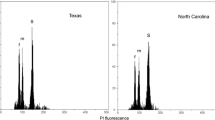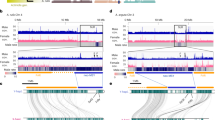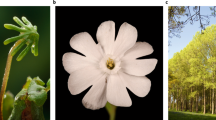Abstract
I HAVE recently been investigating the cytology of a number of dicious plants with the intention, if possible, of throwing light on the matter of sex chromosomes in plants. Incidentally, I took up the genus Lychnis, one species of which, Melandryum rubrum, Garcke (L. dioica, L.), has been examined previously by Strasburger. In detailing his observations he states that, in both sexes, there are twelve pairs of chromosomes present in the somatic cells. In the heterotype division he found one pair of bivalents much larger than the others, but the individual members of this pair were of equal size; thus no signs of the disparity indicating the possibility of two types of microspore were revealed.
This is a preview of subscription content, access via your institution
Access options
Subscribe to this journal
Receive 51 print issues and online access
$199.00 per year
only $3.90 per issue
Buy this article
- Purchase on Springer Link
- Instant access to full article PDF
Prices may be subject to local taxes which are calculated during checkout
Similar content being viewed by others
Author information
Authors and Affiliations
Rights and permissions
About this article
Cite this article
BLACKBURN, K. Sex Chromosomes in Plants. Nature 112, 687–688 (1923). https://doi.org/10.1038/112687c0
Issue Date:
DOI: https://doi.org/10.1038/112687c0
This article is cited by
-
Evolution of a plant sex chromosome driven by expanding pericentromeric recombination suppression
Scientific Reports (2024)
-
Mendel’s terminology and notation reveal his understanding of genetics
Hereditas (2023)
-
Evolution of sex determination and heterogamety changes in section Otites of the genus Silene
Scientific Reports (2019)
-
De novo transcriptome assembly from flower buds of dioecious, gynomonoecious and chemically masculinized female Coccinia grandis reveals genes associated with sex expression and modification
BMC Plant Biology (2017)
-
Review on different mechanisms of sex determination and sex-linked molecular markers in dioecious crops: a current update
Euphytica (2015)
Comments
By submitting a comment you agree to abide by our Terms and Community Guidelines. If you find something abusive or that does not comply with our terms or guidelines please flag it as inappropriate.



